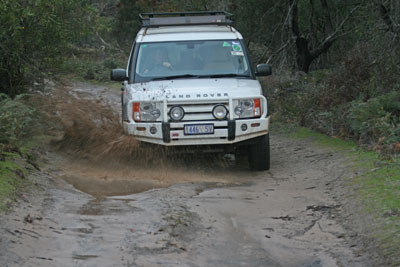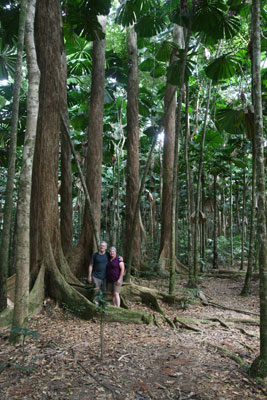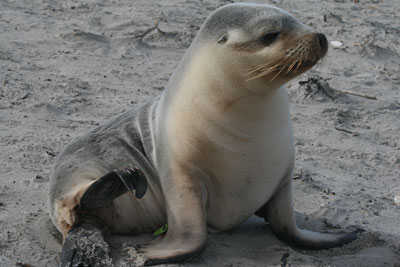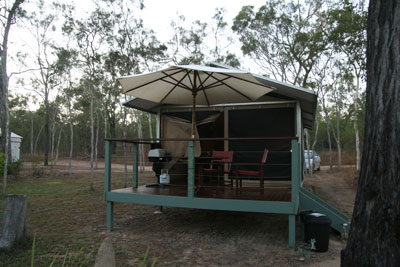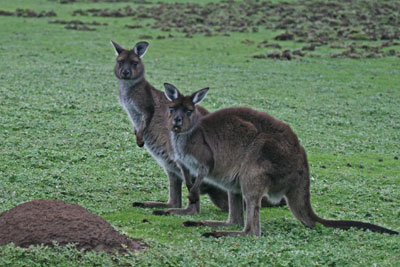Sydney, the Outback and the Great Barrier Reef—touring Australia’s landscape extremes
by Bill & Betty Reed Denton, TX
The mail plane landed on the dirt runway with a few bumps. An old jalopy covered with dust inside and out pulled up, and out stepped a man who’d probably never shaved or had a haircut. His hat was a proud one; sweat-stained and with a cracked rim, it had the gritty reminders of good times pasted all over it.
He greeted Tom, our pilot, and we all jumped into his car. He raised the hood, fiddled underneath and slammed it down.
Off we went to the tune of “zeeee zawwww zeee zawww,” the sound caused by a broken door latch, and soon Tom was slapping his knee in time with the latch, singing Johnny Cash’s “I’ve Been Everywhere” but substituting Australian towns for the originals.
A few verses later we pulled up in front of a small hotel and in we went for tea. Half an hour later Tom said we had to leave to keep on his mail-delivery schedule.
The unshaven one was not about to let us go without showing us his hot tub. He was pretty proud of that tub, which consisted of a hole in the ground fed by an irrigation pipe.
Soon thereafter we hopped in the car and off we went to the plane in a cloud of dust.
The plane was an old Beech twin engine held together partly by duct tape. A few bumps later and we were off to the next cattle station.
Into the Outback
We had driven to Port Augusta, Australia, the night before and called Tom to see if there was room for my wife, Betty, and me on his plane. When you sign up for the mail run through Australia’s Outback, you don’t know until the night before whether there’s room for you or not.
He said, “No room,” so I asked if just one of us could go. Thirty minutes later he called and said he’d located a cattle station that could sell him additional fuel, so we both could go.
“You came all this way and I didn’t want to let you down!”
The pilot did inform us that in two weeks he would be getting a new plane, which would include permanent seats for two passengers, so signing up won’t be as risky in the future. When we went, passengers could fly only if there was not much mail.
The Outback is vast. It fills 95% of a continent the same size as the “lower 48” of the USA. We were there after an unusually wet year, and large areas of green dotted the almost-barren landscape. Occasionally, we passed over a shallow salt lake.
The cattle stations are huge; one of them, until recently, covered some 10,000 square miles and had only one house. We stopped at about a dozen such stations.
This mail plane excursion came near the end of what was probably the best trip we have ever taken. Here are the high points.
Amazing adventures
We started our June-July ’09 trip to Australia in Sydney, where we climbed the Sydney Harbour Bridge. We both hate heights, but it felt safe. We each wore a special suit and were latched to a cable, so even if we jumped off we wouldn’t go far.
The catwalk was wide, gently sloping to the top. The views were fabulous as we looked down on the harbor and the famous Opera House.
Next, we flew to Cairns, got a rental car and drove to Port Douglas, a laid-back town. Walking to town for dinner, we stopped to watch fruit bats (flying foxes), maybe 50 of them, taking off for the night.
We ate at the Ironbar Restaurant (5 Macrossan St.), where I had kangaroo and Betty had a steak. Both were excellent and each cost about $25, which was about what most of our evening meals cost. We didn’t stay for the cane toad races they have in the bar each evening.
Port Douglas
Four Mile Beach was like a picture postcard — wide and ringed by palms and flowering trees. We had most beaches practically to ourselves, but you’d need an IMAX camera or something from the Space Shuttle to capture them properly.
To see the Great Barrier Reef, a UNESCO World Heritage Site, we boarded Synergy, a catamaran. If the wind had been up, we’d have sailed; instead, we motored 20 miles to a buoy. There were only six passengers — far fewer than the hundreds on the big catamarans — and it seemed like we had the reef to ourselves.
During the Aussie winter the water is relatively clear, so you can see thousands of fish and dozens of different corals. We swam along the edge of the reef, moving out of the little bays and inlets. Giant clams were a common sight.
Prehistoric flora
The next day we entered the Daintree Rainforest, another World Heritage Site, after crossing the Daintree River on a car ferry. The area gets about 15 feet of rain per year, so I was glad we were there during the dry season.
Our guide, Murry Antill of Cooper Creek Wilderness Tours, took us into the rainforest, which was spared from logging and farming due to its rocky terrain. The Daintree is one of the few remaining places in the world with plants that go back 135 million years, and new species are discovered there often.
Standing under a canopy of palms, we were in the same forest through which dinosaurs walked. We encountered a large female cassowary and followed her for 20 minutes — carefully, as they can be very dangerous if disturbed.
That evening we took a guided night walk in the same forest and found it to be a very different place. I’d never seen birds sleeping on the ends of thin branches about eye height. They looked like little puff-balls, and as long as we didn’t actually touch the branch, they didn’t wake up.
After Daintree we traveled to the Jabiru Safari Lodge in the Atherton Tablelands, which looks a bit like Ireland without rock fences. The hills were vibrant green, and we visited several beautiful waterfalls in the area.
Kangaroo Island
We continued by plane to Adelaide, the jumping-off place for our visit to Kangaroo Island. The island is small (about 35 by 95 miles) and full of kangaroos, wallabies and koalas. In fact, there are so many koalas that they have to be culled so they don’t destroy their food supply.
Peter Morris, our guide with Kangaroo Island Wilderness Tours, met us at the plane from Adelaide. You need a guide to see the best wildlife spots, as some are on private property.
Across the island were Australian sea lions. Because they can be dangerous, visitors can go to their beach only with a guide. We were told to stay seven meters away, but the animals don’t know the rules. One pup came a few feet from us and sat, staring.
The farmhouse B&B we stayed in, Fillmore’s Lombardy, was new but looked as though it had been there a long time. Waking up and looking out to the green fields and the ocean was really nice. That evening we went to watch the fairy penguins come ashore to feed their young.
This was an absolutely wonderful trip. Karolyn Wrightson of Essential DownUnder Travel (Weaverville, NC; 877/977-4505, www.essentialdownunder.com) spoke with Betty many times to plan the itinerary. If you decide to go, call Karolyn first.
We like to start early, end late, get wet, cold and tired and really get into a country and meet the people. Karolyn tailored the trip to fit our wishes. We wanted to see as much as possible in just over two weeks, and she packed it all in.
The cost for the two of us for our 18-day trip was about $11,000. This included round-trip air from Dallas/Fort Worth, a rental car in some locations, all accommodations, tours, entry fees and airport transfers.
We’d had warm interactions with Aussies everywhere, and I’d begun to feel like one of them.


